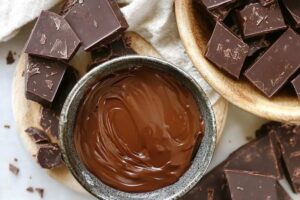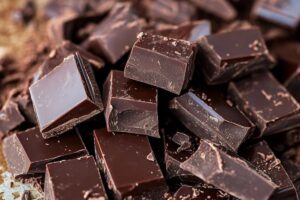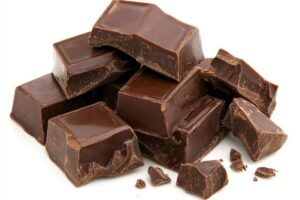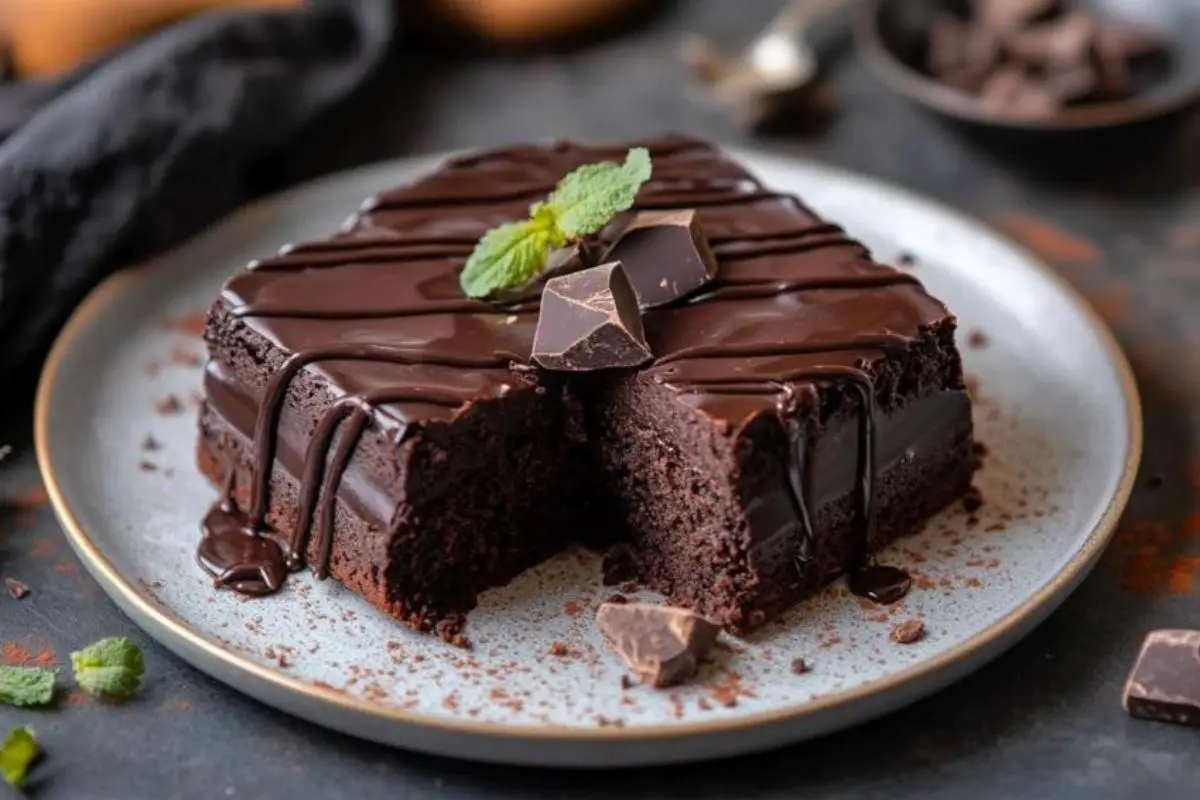Chocolate lovers often find themselves at a crossroads when choosing between chocolate sauce and chocolate fudge for their desserts. While both add a decadent touch to dishes, their textures, preparation methods, ingredients, and usage in desserts differ significantly. If you’re wondering which one is right for your sweet creations, this article will guide you through the key differences between the two.
A Brief Overview of Chocolate Sauce and Chocolate Fudge
Before diving into the detailed comparisons, it’s essential to understand what sets these two chocolate-based confections apart. Both chocolate sauce and chocolate fudge can elevate desserts to the next level, but they cater to different tastes and textures.
What Is Chocolate Sauce?
Chocolate sauce is a smooth, pourable liquid typically made from cocoa powder, sugar, and some form of liquid like water, milk, or cream. It’s often used as a topping for ice cream, cakes, or pancakes. This sauce is thinner and more fluid compared to fudge, making it easy to drizzle over desserts. For a closer look at how to create this versatile treat, check out the guide on making chocolate sauce at home.
What Is Chocolate Fudge?
On the other hand, chocolate fudge is a thick, dense confection made from sugar, butter, milk, and sometimes cocoa. It is typically cooked to a soft-ball stage, cooled, and beaten until it solidifies into a soft, firm texture. Fudge is known for its rich, indulgent flavor and is often served as a standalone treat. To learn more about fudge and its fascinating history, you can visit this resource on the history of chocolate confections.
Key Ingredient Differences
The primary distinction between chocolate sauce and chocolate fudge lies in their ingredients and how they are processed. While they share similar base components, their differing ratios and the inclusion of certain ingredients contribute to their unique textures and flavors.
Chocolate Sauce Ingredients

The basic ingredients for chocolate sauce include:
- Cocoa powder or melted chocolate
- Sugar
- Milk, water, or cream
- Vanilla extract (optional)
- Salt (optional)
The key to chocolate sauce is its balance of sweetness and liquidity. The inclusion of liquids like milk or cream gives the sauce a thinner consistency, which makes it ideal for drizzling over desserts. You can also modify chocolate sauce by adding flavor enhancers like coffee, cinnamon, or even liqueurs for a more sophisticated twist.
Chocolate Fudge Ingredients
Chocolate fudge is known for its rich and creamy texture, which comes from a combination of several key ingredients. Here are the main components typically used in making chocolate fudge:
- Butter: Acts as a primary fat source, contributing to the creaminess and rich flavor of the fudge(Recipes FAQs)(Wockenfuss Candies).
- Sugar: Usually granulated sugar, it serves as the main sweetener. The high sugar content is essential for achieving the desired texture(The Cooking Facts)(LEAFtv).
- Milk or Cream: Provides moisture and helps to create a smooth, velvety texture. Heavy cream can be used for an even richer fudge(Tasting Table)(Wockenfuss Candies).
- Chocolate: Either cocoa powder or melted chocolate is included for flavor. The choice of chocolate can significantly affect the richness and depth of flavor(Recipes FAQs)(LEAFtv).
- Vanilla Extract: Often added for flavor enhancement, giving the fudge a pleasant aromatic quality(Tasting Tabl)(Wockenfuss Candies).
- Optional Ingredients: Nuts, marshmallows, or other flavorings can be included for additional texture and taste variations(The Cooking Facts)(Wockenfuss Candies).
The combination of these ingredients creates the signature dense and indulgent texture that makes chocolate fudge a favorite treat. For more detailed recipes and variations, you can check out resources from Wockenfuss Candies and Fine Cooking.
Why Ingredients Matter
The inclusion of butter and more sugar in fudge results in a firm, solid texture. Meanwhile, chocolate sauce remains fluid because it lacks these hardening agents. Fudge is more akin to candy, while chocolate sauce acts as a topping. This significant difference in ingredients explains why chocolate sauce is ideal for adding a light layer of chocolatey goodness to desserts, whereas fudge offers a more substantial bite.
Texture and Consistency
Perhaps the most apparent distinction between chocolate sauce and chocolate fudge is their textures. These differences are the result of how each product is made and the ingredients involved.
Chocolate Sauce Texture
Chocolate sauce is smooth, liquid, and easily pourable. It has a glossy finish and maintains its fluid consistency even when cooled. This makes it the perfect addition to desserts that need a bit of extra flavor without overwhelming the dish. Think of chocolate sauce as a drizzle or topping that adds just the right amount of sweetness to ice cream, cakes, or waffles.
Chocolate Fudge Texture
By contrast, chocolate fudge is dense, firm, and chewy. When properly prepared, fudge should hold its shape but still be soft enough to melt in your mouth. Unlike chocolate sauce, which spreads easily, fudge can be sliced into squares or molded into shapes, giving it more versatility as a candy.
The difference in texture is due to the crystallization of sugar in the fudge-making process. When making fudge, the mixture is heated to a specific temperature (usually the soft-ball stage, around 234°F or 112°C), then cooled and beaten to achieve a smooth, creamy consistency. This is what makes fudge so distinct from sauces or syrups.
Cooking Techniques

How to Make Chocolate Sauce
Making chocolate sauce is relatively simple. Here’s a basic overview of the process:
- Combine cocoa powder (or melted chocolate), sugar, and milk in a saucepan.
- Heat the mixture over medium heat, stirring constantly to dissolve the sugar.
- Bring to a gentle simmer, allowing the sauce to thicken slightly.
- Remove from heat and stir in vanilla extract for flavor.
Chocolate sauce requires careful attention to avoid burning the chocolate, but it is generally quicker and easier to prepare than fudge.
How to Make Chocolate Fudge
The process for making chocolate fudge is more complex and involves the following steps:
- Heat sugar, butter, and milk in a saucepan until the sugar dissolves.
- Bring the mixture to a boil and cook until it reaches the soft-ball stage (around 234°F or 112°C). A candy thermometer is essential for accuracy.
- Remove from heat and add chocolate (if using cocoa powder, add it earlier in the process).
- Beat the mixture vigorously until it begins to thicken and loses its gloss.
- Pour the fudge into a prepared pan and allow it to cool and set before slicing.
Fudge requires precise timing and temperature control to achieve the correct consistency. If the mixture isn’t cooked long enough, it may remain too soft; if overcooked, it can become grainy.
Flavor Profiles: Chocolate Sauce vs. Chocolate Fudge
Chocolate Sauce Flavor
Chocolate Flavor
fudge Chocolate is far richer and more decadent due to the combination of butter, cream, and chocolate. The high fat content creates a creamy mouthfeel and deepens the overall flavor profile, making fudge a more indulgent treat. While it’s still sweet, fudge has a more balanced taste because the richness of the butter and cream counteracts the sweetness of the sugar.
Common Uses in Desserts
Both chocolate sauce and chocolate fudge play significant roles in the world of desserts, each catering to different needs and preferences. Here’s a breakdown of their common uses:
Uses for Chocolate Sauce
- Topping for Ice Cream: Often drizzled over ice cream, chocolate sauce enhances flavor and adds a sweet, chocolaty touch. Its smooth, pourable consistency makes it ideal for creating beautiful sundaes(Recipes FAQs)(Tasting Table).
- Pancakes and Waffles: A popular choice for breakfast or dessert, chocolate sauce pairs wonderfully with pancakes and waffles, offering a sweet contrast to their fluffiness(LEAFtv).
- Beverage Enhancer: This sauce is commonly used in drinks like chocolate milk and hot chocolate. Mixing it into milk creates a deliciously sweet beverage, perfect for any chocolate lover(The Cooking Facts).
- Drizzle for Cakes and Brownies: It works well on cakes, brownies, and other baked goods, enhancing both flavor and visual appeal. This is especially effective for chocolate cakes, where it elevates the overall experience(Wockenfuss Candies).
- Fruit Dip: Fresh fruits, such as strawberries and bananas, become delightful snacks or desserts when dipped in chocolate sauce. The combination of fresh fruit and rich chocolate is always a hit(Tasting Table).
Uses for Chocolate Fudge
- Stand-Alone Treat: Chocolate fudge is often enjoyed on its own. It can be cut into squares and served as a candy or dessert, making it a popular choice for gifts(The Cooking Facts)(Wockenfuss Candies).
- Layered in Brownies: This fudge can serve as a rich, gooey layer within brownies or other baked goods, creating a decadent treat that adds both texture and flavor(Recipes FAQs).
- Topping for Desserts: Similar to sauce, chocolate fudge can also top desserts like brownies or ice cream sundaes. Its thicker consistency provides a rich contrast to lighter elements(LEAFtv).
- Baked Goods Filling: Fudge works well as a filling in various baked goods, adding a sweet surprise when bitten into(Wockenfuss Candies).
Both chocolate sauce and chocolate fudge can elevate a wide range of desserts. Understanding their common uses helps you decide which one to incorporate into your culinary creations. For more detailed recipes and ideas, you can explore additional resources on chocolate sauce and chocolate fudge.
Which Is Healthier?
Both chocolate sauce and chocolate fudge offer some benefits when consumed in moderation. Cocoa contains antioxidants and flavonoids, which have been shown to improve heart health and reduce inflammation. However, due to its higher fat and sugar content, chocolate fudge should be eaten less frequently than chocolate sauce, especially for those watching their calorie or fat intake.
FAQs
What is the difference between chocolate syrup and chocolate sauce?
Chocolate syrup is thinner and often sweeter than chocolate sauce. While both can be used as toppings, chocolate syrup is typically made from cocoa powder, sugar, and water, making it a quick and easy option for adding a chocolate flavor to beverages and desserts. Chocolate sauce, however, is richer due to the inclusion of cream or milk, which gives it a thicker consistency(Recipes FAQs)(Tasting Table).
Can hot fudge be used in place of chocolate sauce?
Yes, hot fudge can be used in place of chocolate sauce, but keep in mind that it will provide a richer and denser texture. Hot fudge is best used on desserts like sundaes or brownies, where its thick consistency complements the dish(LEAFtv)(Wockenfuss Candies).
Is chocolate fudge healthier than chocolate sauce?
Generally, no. Chocolate fudge contains more sugar and fat than chocolate sauce, making it a more calorie-dense option. If you’re looking for a lighter choice, chocolate sauce is preferable, especially for those who want to enjoy chocolate without the extra calories(The Cooking Facts)(Recipes FAQs).

Conclusion: Choosing Between Chocolate Sauce and Chocolate Fudge
In summary, while both chocolate sauce and chocolate fudge are delicious and versatile, they serve different purposes in the culinary world. If you’re looking for something light and easy to drizzle, chocolate sauce is your go-to option. However, if you’re after something rich and decadent, chocolate fudge is the clear winner. Understanding the differences in ingredients, preparation, texture, and flavor can help you make informed choices when crafting your desserts. Whether you opt for the ease of chocolate sauce or the indulgence of fudge, both will bring a delightful chocolatey experience to your table.

